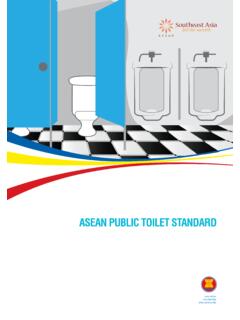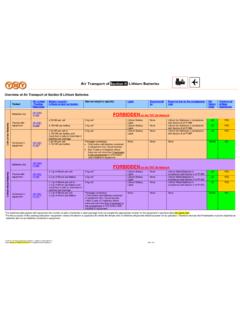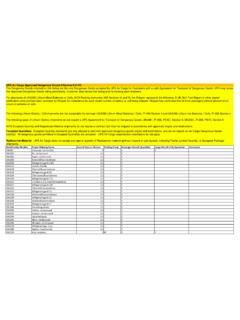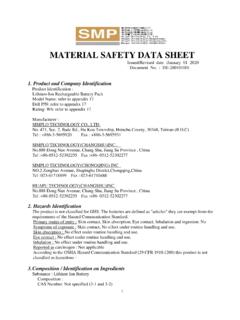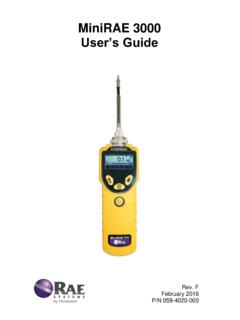Transcription of Dangerous Goods Handling (All modes)” has been ... - ASEAN
1 The Training Material on Dangerous Goods Handling (All modes) has been produced under Project Sustainable Human Resource Development in Logistic Services for ASEAN Member States with the support from Japan- ASEAN Integration Fund (JAIF). Copyright Association of Southeast Asian Nations ( ASEAN ) 2014. All rights reserved. Dangerous Goods Handling Chapter 4-1 Page 2 Oct 2014 Chapter 4-2: IATA Dangerous Goods Regulations (IATA DGR) Objectives This chapter will cover the basic understanding on the applicable transport regulation by Air (IATA Dangerous Goods Regulations : IATA DGR) The Background, Development and Principles of IATA DGR will be explained. Sections of IATA DGR will be briefly elaborated.
2 It covers Basic Hazard Classification and Hazard Communication under IATA DGR. The core element of the IATA DGR will be explained on how to read the information in Blue Pages ( DG List) The Training Requirements under IATA DGR will be explained. The example of how to use IATA DGR will also be demonstrated. 1. Introduction Background of IATA DGR To provide procedures for the shipper and operator by which the articles and substances with hazardous properties can be safely transported by air on all air commercial transport . In 1953, the Member airlines of IATA recognized the growing need to transport by air, article and substances having hazardous properties which, if uncontrolled, could adversely affect the safety of the passengers, crew and/or aircraft on which they are carried.
3 Most such articles and substances could be carried safely provided that they were properly packed and the quantities in each package were properly limited. Development of IATA DGR The first version was published in 1956 as the IATA Restricted Articles Regulations, A Manual of Industry Carrier Regulations to be followed by all IATA member airlines. The latest edition is 55th Edition with effective 1st January 31st December 2014 published by the IATA Dangerous Goods Boards. Figure 4-2-1: IATA Dangerous Goods Regulations, 55 Edition (2014) Dangerous Goods Handling Chapter 4-1 Page 3 Oct 2014 Principles of IATA DGR The IATA DGR is an easy-to-use manual based on the International Civil Aviation Organization (ICAO) Technical Instructions for the Safe transport of Dangerous Goods by Air.
4 It incorporates additional operational requirements, which provide harmonized system for operators to accept and transport Dangerous Goods safely and efficiently. It also includes a detailed list of individual articles and substances specifying the United Nations classification of each article or substance and their acceptability as well as the conditions for air transport . Identification of Dangerous Goods by Air Basically Dangerous Goods when shipped by aircrafts can be mainly classified into 4 types as below:- 1. Forbidden under any circumstances 2. Forbidden under normal circumstances but may be carried with specific approvals from the States concerned. 3. Restricted to carriage on all cargo aircraft (CAO) 4.
5 Can be carried on passenger aircraft provided certain requirements are met. Packaging as Essential Component of DG transport Packing Instructions (PI) are provided with a wide range of options (inner, outer, single packagings). Normally requires the use of UN performance-tested specification packagings except when shipped in Limited Quantity ( Y Packing Instructions). The quantity of Dangerous Goods permitted within these packaging is strictly limited as to minimize the risk should an accident occur. Sections in IATA DGR Like other Dangerous Goods recommendations and regulations, The IATA Dangerous Goods Regulations have been structured and designed to be an easy-to-use manual. It contains various sections as listed below:- section 1: Applicability section 2: Limitations section 3: Classification section 4: Identification (Blue pages) section 5: Packing section 6: Packing Specifications and Performance Tests section 7: Marking and Labelling section 8: Documentation section 9: Handling section 10: Radioactive Materials Appendices A: Glossary Appendices B: Nomenclature (symbols, units & conversion tables) Appendices C: Currently assigned Substances (Div ) Appendices D: IATA Members, Associate Members and other Airlines Appendices E: Competent Authorities Dangerous Goods Handling Chapter 4-1 Page 4 Oct 2014 Appendices G: Related Services Appendices H.
6 IATA Safety Standard Programmes Index Each section is further divided into numbered Subsections and paragraphs. = section 1 (1) Subsection 3 ( ) Paragraph 3 ( ) Subparagraph 2 ( ) Sub-subparagraph 1 ( ) Table section 3 (3) Subsection 3 ( ) 1st Table A ( ) Dangerous Goods Classification under IATA DGR Classification of Dangerous Goods in IATA DGR is purely based on the UN Model Regulations and keeps being updated in every new edition. The Dangerous Goods are classified into 9 Classes. Some classes are also sub-classified into Divisions with Packing Groups. In order to give a quick review of 9 Classes of Dangerous Goods , following details once again summarize all the 9 Classes and relevant division as below:- Class 1: Explosives Division : substances and articles which have a mass explosion hazard Division : substances and articles which have a projection hazard but not a mass explosion hazard Division : substances and articles which have a fire hazard and either a minor blast hazard or a minor projection hazard or both, but not a mass explosion hazard Division : substances and articles which present no significant hazard Division : very insensitive substances which have a mass explosion hazard Division.
7 Extremely insensitive articles which do not have a mass explosion hazard Class 2: Gases Class : flammable gases Class : non-flammable, non-toxic gases Class : toxic gases Class 3: Flammable liquids Class 4: Flammable solids; substances liable to spontaneous combustion; substances which, in contact with water, emit flammable gases Dangerous Goods Handling Chapter 4-1 Page 5 Oct 2014 Class : flammable solids, self-reactive substances and solid desensitized explosives Class : substances liable to spontaneous combustion Class : substances which, in contact with water, emit flammable gases Class 5: Oxidizing substances and organic peroxides Class : oxidizing substances Class : organic peroxides Class 6: Toxic and infectious substances Class : toxic substances Class : infectious substances Class 7: Radioactive material Class 8: Corrosive substances Class 9.
8 Miscellaneous Dangerous substances and articles The numerical order of the classes and divisions is not that of the degree of danger. These 9 hazard classes have been established internationally by a United Nations (UN) committee to ensure that all modes of transport (road, rail, air and sea) classify Dangerous Goods in the same way. Hazard Communication under IATA DGR Basically the hazard communication for all 9 classes tends to be the same as other regulations. However there are some special labels which are mainly used for international air transport of Dangerous Goods only. To clearly understand the strict consignment procedure, it is highly recommended that readers refer to the full text of IATA Dangerous Goods regulations whereas assuring that the proper IATA DGR training has been conducted and certified.
9 This chapter aims at giving a quick snapshot of comprehensive understanding and does not cover all detailed procedures in full compliance with IATA DGR requirements. The other additional Handling labels in addition to hazard class labels are:- Magnetized Materials Lithium Batteries Limited and Excepted Quantities Cargo Aircraft Only Environmentally Hazardous Substances Cryogenic Liquid Keep Away from Heat Time & Temperature Sensitive Orientation Dangerous Goods Handling Chapter 4-1 Page 6 Oct 2014 Figure 4-2-2: IATA Dangerous Goods Hazard and Handling Labels Understanding the Blue Pages ( Dangerous Goods List) This section of the IATA Dangerous Goods Regulations is commonly called Blue Pages due to the fact that its color is in blue.
10 It can be easily identified by looking at the side the text book. The actual part of this book is in fact called Dangerous Goods List which is similar to all other regulations which is a core section in identifying the substances and mixtures and relevant information in the regulations. Structure of Dangerous Goods List (DGL) The DGL is divided into 14 columns for each individual Dangerous good listed. Much of the information contained in the DGL is coded to make it easier to present in a table. The DGL is arranged in UN Number order; column 1. To look up an entry, the readers just need to have the UN Number. Column A UN Number Contains the serial number assigned to the article or substance under United Nations Classification System.







